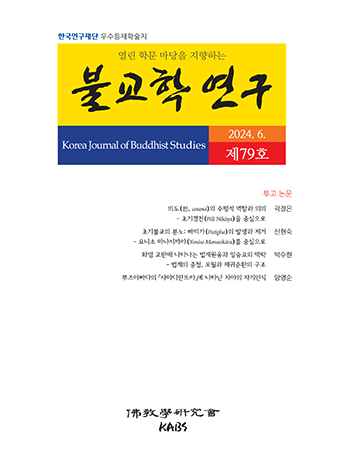Abstract
References
Sorry, not available.
Click the PDF button.
Information
This article investigates the characteristics of the Huayan theory of zhongxing(種性 gotra, clan or lineage) in Kyun-nyo(均如) of the Koryeo dynasty in the history of the Huayan theory of zhongxing. The view of Zhi-yan(智嚴) as the estab\-lisher of Huayan studies on Zhongxing was focused on prac\-tice. This view became the basic understanding of zhongxing in the Huayan scholars of East Asia through Fazang(法藏).Fazang’s thought on Zhongxing can be ascertained in the Huayanjiaofenji(華嚴敎分記). Through the analysis of Kyun-nyo’ s commentary on it in also be ascertained to have been partly composed of a misunderstanding of it. Although such phe\-nomena occur generally among Huayan scholars, Kyun-nyo’ s distinctive understanding can be extracted through its com\-parison with the Kegonshū shushōgishō(華嚴宗種性義抄) in the Heian period of Japan.Kyun-nyo’s understanding of zhongxing inherits Fazang’ s by and large, his establishment of the characteristics of the significance of Zhongxing in the Final teachings is especially based upon the illumination of Benjue(本覺, original awak\-ening) from diverse perspectives. In addition, he clarifies it through the citation of Fazang’s Qixinbieji(起信別記, Addi\-tional Commentary on the Awakening of Faith in Mahayana) in order to prove its relation with the thought of Bao Fu(報佛, Recompensed Buddha), which is a result of his partial mis\-understanding of Fazang’s thought in its logic. He also thor\-oughly investigated the commentaries of the Faxiang(法相) school in order to criticize the doctrines of the Faxiang Weishi (法相唯識), understanding the Mahāyāna-saṃgraha belonging to the Final teachings in relation to the Elementary teachings in his critical attitude to the Elementary Teachings on the basis of the Final teachings. Further, he maintains a critical attitude toward the theory of zhongxing in the Final teachings. These series of steps as preparatory works in order to establish fi\-nally the doctrine of Yuanjiao(圓敎) in its perfection can be interpreted to be the deepening of Huayan thought through commentarial works in misunderstanding.
본 고는 화엄의 종성론을 테마로 해서, 고려시대 균여의 화엄 종성론의 특징을 검토하는데 그 목적이 있다. 현장이 인도에서 귀국한 이후 발생한 구유식학파와 신유식학파의 논쟁은 종성에 대한 이해의 차이에서 비롯되었다. 종성논쟁은 본질적으로 유식학파간의 논쟁이었지만, 당시에 종남산에서 거주하던 화엄학자 지엄도 이에 대한 자신의 의견을 저술에서 피력하게 된다. 지엄의 견해는 수행을 중시한 종성론이다. 이러한 지엄의 견해는 법장을 통해 동아시아 화엄가들의 기본 입장이 된다. 법장의 종성론에 대한 사유는 『화엄교분기』에서 확인할 수 있다. 균여가 『석화엄교분기원통초』에서 이 부분에 대해 주석한 내용을 검토하면, 균여의 이해 가운데 오해에 의해 구성된 부분을 지적할 수 있다. 이러한 부분은 화엄가의 공통적 현상이긴 하지만, 일본 헤이안시대에 쓰여진 『화엄종성의』와의 비교를 통해 균여만의 특징을 추출할 수 있다. 균여의 종성의는 법장을 답습하기는 하지만, 종교 종성의의 성격 규정에 있어 본각을 여러 각도에서 비춰본다. 또 종성이 보불과 관련 있는 것을 증명하기 위해 법장의 『기신별기』를 인용하여 그 명증성을 기한다. 그것은 오히려 법장 사유에 대한 약간의 오해로부터 비롯한 논리였다. 또한 법상유식파를 비판하기 위해 법상종의 논소를 적극적으로 해석하는데, 종교에 해당하는 『섭대승론』을 시교와 관련시켜 이해하여 종교의 입장에서 시교에 대해 비판적인 태도를 취하는 방법을 사용하기도 한다. 나아가 종교의 종성론에 대해서도 또한 비판적인 입장을 견지한다. 이러한 일련의 단계는 결국 완성된 원교의 교리를 도출하기 위한 사전 작업이라는 점에서도 오해에 근거한 주석을 통해 화엄교리가 심화된 것이라고 해석할 수 있다.
Click the PDF button.
- Publisher :Korean Association of Buddhist Studies
- Publisher(Ko) :불교학연구회
- Journal Title :Korea Journal of Buddhist Studies
- Journal Title(Ko) :불교학연구
- Volume : 25
- No :0
- Pages :49 ~ 79


 Korea Journal of Buddhist Studies
Korea Journal of Buddhist Studies






